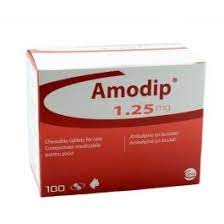Amodip® 1.25 mg chewable tablets for cats Species: Cats Therapeutic indication: Pharmaceuticals: Cardiovascular and respiratory preparations Active ingredient: Amlodipine Product:Amodip® 1.25 mg chewable tablets for cats Product index: Amodip Qualitative and quantitative composition Each tablet contains Active substance: Amlodipine 1.25 mg (Equivalent to 1.73 mg of amlodipine besilate) Excipients: For the full list of excipients, see section Pharmaceutical particulars. Pharmaceutical form Chewable tablet. Oblong in shape, score line on one side, beige to light brown tablets. Tablets can be divided into two equal parts. Clinical particulars Target species Cats Indications for use, specifying the target species For the treatment of systemic hypertension in cats. Contraindications Do not use in the case of cardiogenic shock and severe aortic stenosis. Do not use in cases of severe hepatic failure. Do not use in cases of known hypersensitivity to the active substance or to any of the excipients. Special warnings for each target species The primary cause and/or co-morbidities of hypertension, such as hyperthyroidism, chronic kidney disease and diabetes, should be identified and treated. In cats situational hypertension (also called white coat hypertension) occurs as a consequence of the in-clinic measurement process in an otherwise normotensive animal. In case of high stress levels measurement of systolic blood pressure may lead to incorrect diagnosis of hypertension. It is recommended that stable hypertension is confirmed by repeated measurement of systolic blood pressure on different days before commencing therapy. Continued administration of the product over an extended period of time should be in accordance with an ongoing benefit/ risk evaluation, performedby the prescribing veterinarian that includes measurement of systolic blood pressure routinely during treatment (e.g. every 6 to 8 weeks). Special precautions for use Special precautions for use in animals: Special caution is required in patients with hepatic disease as amlodipine is highly metabolised by the liver. As no studies have been conducted in animals with liver disease, use of the product in these animals should be based on a benefit-risk assessment by the attending veterinarian. Administration of amlodipine may sometimes result in a decrease in serum potassium and chloride levels. Monitoring of those levels is recommended during treatment. Older cats with hypertension and chronic kidney disease (CKD) may also suffer from hypokalaemia as a result of their underlying disease. The safety of amlodipine has not been established in cats weighing less than 2.5 kg. Safety has not been tested in cats with cardiac failure. Use in these cases should be based on a benefit risk assessment by the veterinarian. The chewable tablets are flavoured. In order to avoid any accidental ingestion, store tablets out of reach of the animals. Special precautions to be taken by the person administering the veterinary medicinal product to animals This product may decrease blood pressure. In order to reduce the risk of accidental ingestion by children, do not take the tablets out of blisters until ready to administer to the animal. Return part-used tablets into the blister and carton. In case of accidental oral ingestion, seek medical advice and show the label or the package leaflet to the physician. People with known hypersensitivity to amlodipine should avoid contact with the veterinary medicinal product. Wash hands after use. Adverse reactions (frequency and seriousness) Mild and transient emesis was a very common adverse event in the clinical trial (13%). Common adverse events were mild and transient digestive tract disorders (e.g. anorexia or diarrhoea), lethargy and dehydration. At the dose of 0.25 mg/kg, mild hyperplastic gingivitis with some enlargement of submandibular lymph nodes has been very commonly observed in healthy young adult cats in clinical trials and very rarely in elderly cats based on the post-marketing experience. This does not usually require stopping the treatment. Use during pregnancy, lactation or lay Laboratory studies in rodents have not produced any evidence of teratogenicity or reproductive toxicity. The safety of amlodipine has not been established during pregnancy or lactation in cats. Use only in accordance with the risk-benefit assessment by the responsible veterinarian. Interaction with other medicinal products and other forms of interaction Concomitant use of amlodipine with other agents that may reduce blood pressure may cause hypotension. These agents include: diuretics, beta-blockers, other calcium channel blockers, inhibitors of the renin angiotensin aldosterone system (renin inhibitors, angiotensin II receptor blockers, angiotensin converting enzyme inhibitors (ACEI), and aldosterone antagonists), other vasodilators and alpha-2 agonists. It is advised to measure blood pressure before administering amlodipine with these agents and to ensure cats are adequately hydrated. However, in clinical cases of feline hypertension, no evidence of hypotension occurring as a result of combining amlodipine with the ACEI benazepril was observed. Concomitant use of amlodipine with negative chronotropes and inotropes (such as beta-blockers, cardioselective calcium channel blockers and antifungal azoles (e.g itraconazole) may reduce force and rate of contraction of the heart muscle. Particular attention must be paid before administering amlodipine with these drugs in cats with ventricular dysfunction. The safety of concomitant use of amlodipine and the anti-emetic agents dolasetron and ondansetron has not been evaluated in cats. Amounts to be administered and administration route Oral use. Amlodipine tablets should be administered orally at a recommended starting dose of 0.125 - 0.25 mg/kg/day. After 14 days of treatment, the dose may subsequently be doubled or increased up to 0.5 mg/kg once daily if adequate clinical response has not been achieved (e.g. systolic blood pressure remaining over 150 mmHg or a decrease of less than 15% from the pre-treatment measurement). Weight of cat (kg) Starting dose (number of tablets) 2.5 - 5.0 0.5 5.1 - 10.0 1 10.1 and above 2 The tablets can be given directly to the animals or administered with a small quantity of food. Overdose (symptoms, emergency procedures, antidotes), if necessary Reversible hypotension may occur in cases of accidental overdose. Therapy is symptomatic. After administration of 0.75 mg/kg and 1.25 mg/kg once daily for 6 months to healthy young adult cats, hyperplastic gingivitis, reactive lymphoid hyperplasia in mandibular lymph nodes, and increased Leydig cell vacuolisation and hyperplasia were seen. At the same dose levels plasma potassium and chloride levels were decreased and an increase in urinary volume associated with decreased urinary specific gravity was observed. These effects are unlikely to be observed under clinical conditions with short term accidental overdosing. In a small two-week tolerance study of healthy cats (n=4), doses between 1.75 mg/kg and 2.5 mg/kg were administered, and mortality (n=1) and severe morbidity (n=1) occurred. Withdrawal period Not applicable. Pharmacological particulars Pharmacotherapeutic group: Calcium channel blockers. ATCvet code: QC08CA01 Pharmacodynamic properties Amlodipine is a voltage dependent calcium channel blocker, member of the dihydropyridine group, binding selectively to the L-type of channels found in vascular smooth muscle, cardiac muscle and cardiac nodal tissue. Amlodipine favours the L-type calcium channels found in vascular smooth muscle acting hence predominantly by decreasing vascular resistance. The major blood pressure lowering effect of amlodipine is related to its dilatory action on arteries and arterioles, while amlodipine has little effect on the venous circulation. The duration and waning of anti-hypertensive effects are dose-dependent. Although amlodipine has a greater affinity for the vascular L-type calcium channels, it can also act on those found in the cardiac muscle and cardiac nodal tissue. A decrease in heart rate and a negative inotropic effect on the heart have been observed in vitro in guinea-pig isolated hearts. In a 26-week target animal safety study conducted in cats, amlodipine, at a dose of 0.25 to 1.25 mg/kg administered orally, did not affect heart rate and no electrocardiogram (ECG) abnormalities were observed. Binding of amlodipine to the L-type calcium channels is slow, avoiding hence rapid reductions in blood pressure which lead to reflex tachycardia as a result of activation of baroreceptors. In cats with hypertension, once daily dosing with amlodipine tablets provided clinically significant reductions in blood pressure and due to the slow onset of action of amlodipine, acute hypotension and reflex tachycardia tend not to occur. In vitro data showed amlodipine improves endothelial cell function by increasing the generation of nitric oxide and through anti-oxidant and anti-inflammatory actions. In humans, this is an important effect as endothelial dysfunction accompanies hypertension, coronary heart disease and diabetes, all conditions in which amlodipine is used as part of the treatment regimen. In cats, the importance of these additional effects remains to be determined since the role of endothelial dysfunction in the pathophysiology of feline hypertension has, so far, not been studied. The kidney is, along with the heart, the eye and the CNS, a major target organ of hypertension receiving 20 to 25% of the cardiac output and having a high pressure first capillary bed (the glomerular capillary bed) to facilitate the formation of glomerular filtrate. Calcium channel blockers such as amlodipine are thought to preferentially dilate the afferent arteriole over the efferent arteriole. Since ACEI preferentially dilate the efferent arteriole, they lower the intraglomerular pressure and frequently decrease the magnitude of proteinuria. For this reason, combination of ACEI and calcium channel blockers may be especially beneficial in hypertensive cats with proteinuria. In a clinical study, a field-representative sample of client-owned cats with persistent hypertension (systolic blood pressure (SBP) >165 mmHg) were randomised to receive amlodipine (initial dose of 0.125-0.25 mg/kg, rising to 0.25 - 0.50 mg/kg if response was not satisfactory after 14 days) or placebo, once daily. SBP was measured after 28 days and treatment was considered successful if SBP was reduced by 15% or more of pre-treatment SBP or to below 150 mmHg. 25 out of 40 cats (62.5%) given amlodipine were successfully treated compared with 6 out of 34 (17.6%) given placebo. It was estimated that amlodipine treated animals have 8 times greater odds of treatment success than placebo treated cats (OR 7.94, 95% confidence interval 2.62 - 24.09). Pharmacokinetic particulars Absorption After oral administration of therapeutic doses, amlodipine is well absorbed with peak plasma levels between 3 to 6 hours post dose. After a single dose of 0.25 mg/kg, absolute bioavailability is estimated to be 74% and the peak plasma level is 25 ng/ml, in fasted state. Absorption of amlodipine is not influenced by concomitant food intake in humans. Amlodipine tablet may be given with or without food to cats in clinical use. Distribution The pKa of amlodipine is 8.6. Amlodipine is highly bound to plasma proteins. In vitro protein binding in cat plasma is 97%. The volume of distribution is approximately 10 l/kg. Biotransformation Amlodipine is extensively metabolised by the liver in laboratory animals and humans. All known metabolites lack pharmacological activity. All amlodipine metabolites found in vitro in cat hepatocytes have been earlier identified in incubations of rat, dog and human hepatocytes. Thus, none of them are unique to the cat. Elimination The mean plasma elimination half-life of amlodipine is 53 hours in healthy cats. At 0.125 mg/kg/day, plasma level of amlodipine was approaching steady-state by 2 weeks in healthy cats. Total plasma clearance in healthy cats is estimated to be 2.3 ml/min/kg. Excretion balance has been characterised in humans and several animal species, but not in the cat. In dogs, equal distribution of radioactivity was found in the urine and faeces. Pharmaceutical particulars List of excipients Artificial chicken flavour, Malted yeast, Microcrystalline cellulose, Mannitol, Croscarmellose sodium, Magnesium stearate, Silica colloidal anhydrous. Major Incompatibilities Not applicable.




